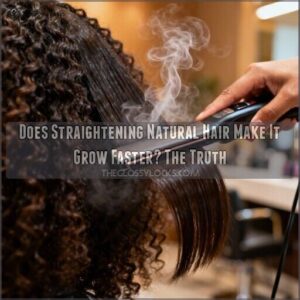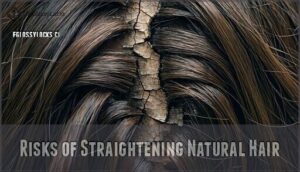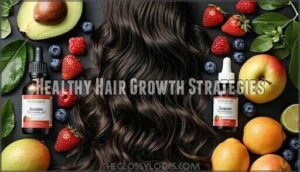This site is supported by our readers. We may earn a commission, at no cost to you, if you purchase through links.

But here’s where things get interesting: what you do with your flat iron can affect how much length you keep, not how fast your hair grows from the root. Understanding the difference saves you time, keeps your hair healthier, and sheds light on what really makes hair thrive.
Table Of Contents
- Key Takeaways
- Does Straightening Natural Hair Boost Growth?
- How Straightening Affects Length Retention
- Risks of Straightening Natural Hair
- Best Practices for Straight Hair Care
- Healthy Hair Growth Strategies
- Frequently Asked Questions (FAQs)
- Is there any way to prevent breakage when straightening natural hair?
- How often should I trim my natural hair when straightening it?
- Can straightening affect hair color or texture over time?
- What are signs of hidden heat damage?
- How long does straightened natural hair typically last?
- Is straightened hair more prone to environmental damage?
- Which ingredients should be avoided after straightening hair?
- Conclusion
Key Takeaways
- Straightening your hair doesn’t make it grow faster; growth rate depends on genetics, health, and nutrition.
- Heat styling can help you keep more of your length by reducing tangles and breakage, but it doesn’t affect your roots.
- Flat irons and frequent heat use can weaken hair, cause split ends, and lead to breakage if you’re not careful with protection and temperatures.
- For healthy growth, focus on a good routine with protein treatments, trims, gentle care, and balanced diet rather than relying on straightening alone.
Does Straightening Natural Hair Boost Growth?
You’ve probably heard that straightening makes hair grow faster, but here’s the truth: it doesn’t actually speed up growth at all. What happens at your scalp has nothing to do with whether your hair is curly or straight.
Let’s break down the science behind hair growth, what really influences how fast your hair grows, and whether heat styling plays any role in the process.
Hair Growth Myths Vs. Scientific Facts
Let’s bust some myths about the hair growth cycle. Your hair won’t grow faster from straightening—growth happens at the follicle, influenced by genetic influence, diet impact, and stress effects. Here’s what actually drives hair growth:
- Genetics sets your baseline rate (roughly 0.3–0.4 mm daily)
- Nutrition fuels the cycle (protein, vitamins support active growth)
- Health and hormones regulate phases (growth lasts 2–6 years)
Straightening doesn’t accelerate this biology, but proper hair growth strategies can minimize hair loss and breakage. Regular trims can improve hair’s look, but don’t affect the actual hair growth.
Growth Rate Factors (Genetics, Health, Age)
Your hair growth rate isn’t random—genetics, health, and age are the real drivers. Genetic hair growth sets your baseline, usually around 0.35 mm daily, while ethnic hair growth varies: Asian hair often grows fastest at 355.6 micrometers per day.
Health and hair are tightly linked—nutritional deficiencies in vitamins B12, D, biotin, and iron slow the hair growth cycle and affect hair follicles. Age hair growth declines too: infants average 287.9 micrometers daily, jumping to 345.1 by age three, while hormonal hair growth shifts during menopause reduce rates.
Hair nutrition—protein, vitamins, antioxidants—fuels hair health from the inside out. Hair graying onset varies, and race plays a role, with Caucasians experiencing it earlier than Asians or Africans.
Impact of Straightening on Hair Growth Cycle
Straightening doesn’t speed up the hair growth cycle itself, but it can mess with how long your strands survive before breaking off. Heat damage can push follicles from the anagen phase (growth phase) into telogen (dormancy period) prematurely, shortening growth phase length.
Your hair health suffers when straightening disrupts cycle stage impact, leading to hair damage and breakage that masks actual growth.
How Straightening Affects Length Retention
Straightening doesn’t change how fast your hair grows, but it can help you keep more of the length you’re already gaining. When your hair is straightened, certain protective benefits come into play that reduce breakage and make retention easier.
Let’s look at three ways straightening can help you hold onto your hard-earned length.
Reduced Tangles and Mechanical Breakage
Think of coiled hair like a twisted rope—every loop is a potential snag point, and when your strands knot up against each other, you’re basically asking for breakage with every comb stroke. Straightening temporarily changes the game for retaining length:
- Reduced tangles mean you’re not ripping through knots that cause hair breakage
- Straightened manageability lets you use wider-tooth combs that glide instead of yank
- Mechanical damage drops since straight hair doesn’t interlock like coils do
- Hair length retention improves when detangling benefits outweigh heat risks
Easier Detangling and Manipulation
When you’ve spent twenty minutes wrestling with a wet wash-and-go only to snap off precious inches, you start to understand why some naturals swear by the occasional silk press.
Straight hair lets you glide a widetooth comb through without the wrestling match, cutting down manipulation time and reducing breakage. That ease of detangling translates to less stress on each strand, which means you’re keeping more of what you grow instead of losing it in the sink.
Sebum Distribution and Moisture Retention
Your scalp produces sebum—that natural conditioning oil—but on tightly coiled hair, it barely makes it past your roots before gravity gives up. Straightening acts like paving a highway: sebum spreads down the shaft more efficiently, coating each strand and locking in moisture. This improved oil distribution can boost moisture retention by 30–50%, keeping your hair more flexible and less prone to snapping.
Straightening natural hair helps sebum reach every strand, boosting moisture and making hair more flexible and less prone to breakage
- Sebum spread reaches mid-lengths and ends faster on straight hair, reducing dryness
- Scalp hydration translates to better overall hair moisture when oils can actually travel
- Straightened porosity allows natural oil benefits to seal the cuticle, supporting length retention
Risks of Straightening Natural Hair
Straightening can help you retain length, but it’s not without trade-offs. Heat styling puts your hair at risk for damage that can actually set back your progress.
Let’s look at the main concerns you’ll need to manage if you’re straightening regularly.
Heat Damage and Split Ends
Heat’s toll on your hair isn’t just surface-level—it creates a cascade of damage that starts with cuticle damage and leads directly to split-end formation. When flat irons exceed 300°F, they trigger protein denaturation, converting your hair’s alpha-keratin into weaker beta-keratin. This structural breakdown increases heat-induced porosity, meaning your cuticles lift and separate instead of lying flat.
The cumulative effects of repeated heat styling compound over time—think about it: if you’re heat styling daily, your ends might face 720 exposures before your next trim. Without a heat protectant and proper preventing heat damage strategies, you’re setting yourself up for breakage that no conditioner can fix.
| Heat Damage Type | What Happens |
|---|---|
| Cuticle disruption | Raised, non-overlapping shingles that snag and break |
| Split-end formation | Disulfide bonds break down; ends fork and travel upward |
| Protein loss | Hair becomes brittle, loses elasticity and strength |
| Porosity increase | Moisture escapes faster; hair feels dry and straw-like |
| Pattern alteration | Up to 37.5% of natural curl permanently lost at 428°F |
Protein Loss and Dryness
Straightening doesn’t just scorch your strands—it literally drains the proteins that keep your hair flexible, strong, and able to hold onto moisture. Here’s what protein deficiency looks like:
- Your hair loses elasticity and snaps instead of stretches
- Cuticle damage creates porous shafts that can’t hold hydration
- Moisture balance gets disrupted, leaving ends brittle and straw-like
- Hair protein treatments become essential to rebuild what heat stripped away
Preventing heat damage means pairing heat protectants with regular protein-rich hair treatments to restore strength.
Frequency of Heat Styling and Breakage
The more often you straighten your hair, the faster breakage catches up—think of it like bending a paperclip back and forth until it snaps. Frequent straightening directly correlates with cumulative damage, so heat styling limits should ideally be every three to four weeks.
Each session weakens your cuticle layer a bit more, making damage prevention critical. To minimize the breakage correlation and keep your strands intact, use lower temperatures and quality heat protectants.
Best Practices for Straight Hair Care
If you’re straightening your hair regularly, you need a solid care routine to keep it healthy and protect your length.
The right approach can help you avoid damage while enjoying the benefits of straight styles.
Here’s what you should focus on to maintain strong, thriving hair.
Protective Styling and Low-Manipulation Techniques
When you’re trying to stretch every inch of growth into visible length, protective styling and low-manipulation techniques can be your best allies—they shield your strands from the daily wear and tear that sneaks up and snaps off progress.
Here’s how to keep straightened hair healthy while maximizing retention:
- Wrap or pin curl at night – Use a silk scarf to preserve your style and lock in moisture retention methods without constant re-styling.
- Limit combing to once daily – Excessive hair manipulation causes breakage, so detangle gently when needed and leave it alone otherwise.
- Try hair stretching alternatives – Banding or loose updos offer protective styling benefits without heat, reducing breakage and preserving hair health between straightening sessions.
These hair preservation methods work because they minimize friction and mechanical stress on your strands.
Safe Heat Tools and Temperatures
If you want your straightened hair to stay as healthy as possible, it pays to get picky about which tools you use and how hot you let them get. Choose a flat iron with adjustable temperature control and ceramic or titanium plates—materials that evenly transfer heat for damage prevention.
Always use a heat protectant, and never crank the temperature above 375°F for hair straightening techniques that truly prevent heat damage.
Protein Treatments and Deep Conditioning
Once you’ve got the right tools and temp dialed in, it’s smart to double down on keeping your hair strong and moisturized with regular protein treatments and deep conditioning. Rotate based on your hair’s needs: protein for strength, deep conditioning for moisture balance.
Check product ingredients, and don’t overdo it—protein overload is real. Aim for healthy treatment frequency and careful application techniques.
Night Routines and Maintenance Tips
Keeping your hair smooth and healthy doesn’t stop when you lay your head down—what you do before bed can make all the difference for how straight styles last through the week. Try wrapping with a satin scarf, using silk scarves, or swapping your pillowcase for satin.
Pineappling technique, braid maintenance, and overnight hydration boost hair maintenance while adding a layer of hair protection.
Healthy Hair Growth Strategies
If you want your hair to keep growing healthy and strong, it takes more than just a flat iron. There are a few simple habits that can make a big difference over time.
Let’s look at what really helps your hair thrive from the inside out.
Nutrition and Scalp Health
Think of your scalp as the soil for healthy hair—without the right nutrients, nothing thrives. Vitamin deficiencies can slow growth and cause fragile hair, while hydration effects and barrier function keep follicles healthy.
A balanced diet, targeting the scalp microbiome and using the right hair health supplements, makes a real difference for both hair and scalp health.
Stress Management for Hair Health
Stress has a sneaky way of showing up in your hair, just as much as it does on your face or in your mood. From scalp tension to sudden hormonal shifts, stress & hair health are a package deal.
Try these comprehensive approaches for everyday peace:
- Mindful breathing or yoga
- Scalp massages (even on straight hair)
- Prioritize lifestyle changes that support rest
Regular Trimming and Professional Care
Even with the best at-home routine, there comes a point where a sharp pair of shears and a professional’s touch can make all the difference for your hair’s strength and growth.
Seeing a stylist for regular trims—every three months or so—helps ward off split ends, keeps your straight hair’s ends healthy, and aids your length retention goals.
Alternatives to Heat Straightening
For those days you’d rather skip the heat but still crave smooth hair, it’s worth knowing there are gentle ways to straighten your strands without reaching for a flat iron. Roller setting, hair wrapping, or trying a banding method stretch hair as it dries.
You might also experiment with a tension blowout using cold air, or play with pin curls, flexi rods, and roller sets—classic, healthy styling options.
Frequently Asked Questions (FAQs)
Is there any way to prevent breakage when straightening natural hair?
Imagine treating your hair like a silk ribbon—minimize breakage by applying heat protectants, sticking to gentle detangling, balancing moisture, keeping trims regular, and using protein treatments.
These habits are cornerstones for straight hair care and preventing hair damage.
How often should I trim my natural hair when straightening it?
Trimming straightened hair every three months works for most people, but you might need more frequent trims if split ends show up.
Trim frequency depends on damage assessment, growth monitoring, seasonal trims, and your personal hair maintenance strategies.
Can straightening affect hair color or texture over time?
Color alteration and texture changes can show up with repeated straightening, especially if heat or chemicals are misused.
Long-term effects might mean duller color, looser curls, or a rougher hair shaft—classic signs of straightening impact and heat damage.
What are signs of hidden heat damage?
Subtle heat damage often hides as texture changes, excessive breakage, split ends, and lackluster shine. You’ll notice elasticity loss—hair stretching too far or snapping—and trouble retaining length, even with careful hair styling or a solid straight hair routine.
How long does straightened natural hair typically last?
Straightened natural hair will usually last three to fourteen days, depending on humidity effects, your maintenance routine, product usage, hair porosity, and daily activities.
Lifestyle factors, straight hair care, and even light styling determine how soon hair reverts.
Is straightened hair more prone to environmental damage?
UV exposure, pollution effects, and humidity impact straight hair differently, making it more vulnerable to dryness and heat damage.
Product buildup and water damage can lead to hair reversion, so careful hair care is key for every texture.
Which ingredients should be avoided after straightening hair?
A gentle nudge: after using heat, harsh sulfates and drying alcohols can strip your straight hair, while heavy oils and silicones might cause build-up.
Also, strong proteins can make hair brittle—opt for lighter hair care regimen steps instead.
Conclusion
If growing hair could be as simple as a magical wand—just a few passes of a flat iron and voilà—it would be every curly-haired person’s dream. But the truth is, no matter what Instagram says, will straightening natural hair make it grow faster? Not directly.
What matters most is how well you care for your strands every day, from root to tip. That’s where real growth shows up—steady, patient, and undeniably yours.
- https://new.shapiromd.com/blogs/blog/does-straightening-hair-cause-hair-loss
- https://www.youtube.com/watch?v=t9XNbbFvmJk&vl=en
- https://rhrli.com/blog/hair-straighteners-and-hair-loss/
- https://longhaircareforum.com/threads/do-you-think-straight-hair-makes-hair-grow-faster.158417/
- https://soldejaneiro.com/blogs/hair-care/the-impact-of-heat-styling-on-hair-health










